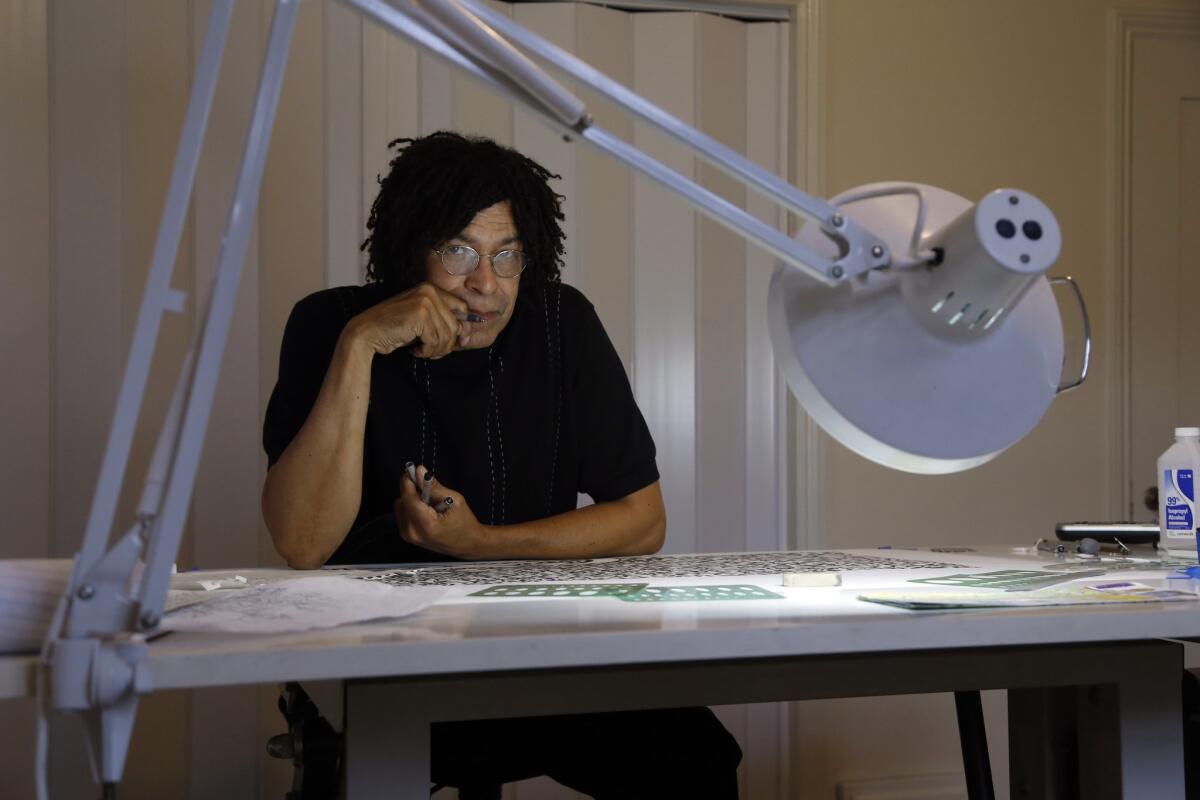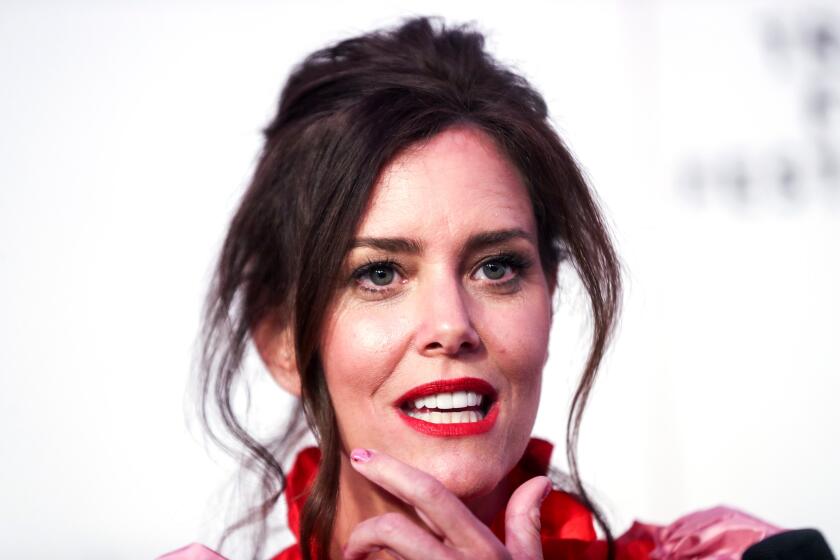Q&A: Artist Mark Steven Greenfield on minstrelsy and American culture

- Share via
Of all the uncomfortable episodes in American history, that of minstrelsy is one that many people would like to forget. It consisted largely of white performers dressed in black-face, employing exaggerated accents and outfits to mimic or degrade aspects of the African slave experience in the United States. The tradition got its start in the mid-1800s and remained a popular form of vernacular theater into the 1900s.
In fact, minstrelsy and black-face are ingrained in some of the most iconic American pop culture of the 20th century: from the 1927 talking picture “The Jazz Singer,” starring Al Jolson, to myriad Warner Bros. cartoons aimed at children. (The University of South Florida has a worthwhile online history devoted to the form.)
It is a touchy topic -- one that L.A. artist Mark Steven Greenfield has spent a good portion of his career tackling head-on, in work that is now on view at the California African American Museum in Los Angeles.
Over the years, he has manipulated old photographs of black-face performers into absurdist eye charts laced with hip-hop lyrics. And he’s taken the symbols of minstrelsy -- top hats, woolen wigs, exaggerated lips -- and abstracted them into playfully subversive geometric patterns.
Greenfield, 63, who has also served as a director of the Watts Towers Arts Center and the Los Angeles Municipal Art gallery, began his career with less controversial subject matter. And the show at CAAM, titled “Lookin’ Back in Front of Me: Selected works of Mark Steven Greenfield, 1974-2014,” features these other works, too: early abstractions that touch on the cosmic, and figurative works tinged by the Afrofuturism of Sun Ra and Parliament Funkadelic.
------------
FOR THE RECORD
Nov. 20, 12:09 p.m.: An earlier version of this article said artist Mark Steven Greenfield was 53 years old. He is 63.
------------
The artist, based in Altadena, now makes art full time. Recently, he talked with me about how he got onto the topic of minstrelsy, what he’s learned from the process, and what his mother thought of it as a subject for his art.
Question: You have a variety of works in the show from throughout your career: portraits, abstractions, sculpture. But there is this clear point, 14 years ago, where the topic of minstrelsy becomes the focus of your work. What inspired you to begin to make work on this phenomenon?
Answer: There’s something that happens in the creative process that I call “gatherings.” It’s the gathering of information and inspiration. At that point, I was working and my job became very demanding. Consequently, there was a period where I didn’t make a lot of work. But I was thinking about questions of genealogy and lineage. And I started to think about the negative aspects of this. There were artists who had used the negative in their work, artists like Kara Walker and Michael Ray Charles and, to some degree Betye Saar. But I really wanted to investigate the origins of it.
Q: You spent more than a decade exploring this as a subject. Why was it important for you to take this on for such a long period of your career?
A: My feeling was that it was time to take ownership of it and to take the power away from it. It does have this ... almost deer-in-headlights [effect]. People see it and they’re shocked. They don’t quite know what to do about it. It’s a specter that’s hung over the American dialogue for a long time. A lot of people don’t want to deal with it. But if you bury it, it will come out and bite you in ways that you never imagined.
In addition, from time to time, I run into [young] people who simply don’t know about it. They’re like, “This really happened?” Or they look at photos of minstrels and they’re like, “What are those?” On some level, particularly with African American youth, there’s a big blank space there. A big question mark of, “Why does the world view me this way?” Well, it’s been this insidious thing in the culture for more than a century. Once you get into the frame with that, then it helps you deal with it.
Q: How was this received by your colleagues and friends?
A: When I first started doing the eye chart pieces, I got a lot of heat. My mother thought I lost my mind. My mom has always been supportive, but she was on the fence about this stuff. You can’t expect everyone to accept it. Older generations are much closer to this. It brings up all kinds of visceral feelings. The way I see it, my generation is starting to work with it. There’s still resistance. But hopefully my children’s generation, they will say, “Oh, that’s important. That’s history.”
Q: In the eye-chart series, you used old photographs of white performers in black-face layered with various texts to create your own charts. How did this series come about?
A: There’s such a tendency to avert your gaze from photographs like this. So I wanted to do a manipulation that would force the viewer to engage with it. After you engage with the text, you look at the photo in a different context. In some ways, the text could be indicative of the indignation you feel when you look at it. Or you could imagine what the photograph might be saying. In some instances, it’s just my reaction to it.
Q: A pair of photographs in the CAAM exhibition are of a pair of young African American artists from CalArts dressed up in black-face. How did that come about?
A: That’s Jason White and Aaron White. [No relation.] They did this play called “The Dance: The History of American Minstrelsy” and it ran for about two and a half months in Leimert Park. It was a minstrel play about the history of minstrelsy. I saw it and was completely floored. After the play, they remove their make-up in front of the audience. In seeing it, I felt like they were trying to do what I was trying to do. I asked if I could photograph them in make-up.
It was serendipitous because I shot them against this black background. So when you’re looking at the picture you see yourself reflected and you see that they’re looking at you, and they see that you are looking at you in horror, or they’re looking at you like you’re a joke. I think the pieces work well. I just regret that I didn’t do them a little larger.
Q: You have a series of cartoon-ish portraits of popular entertainers who employed black-face, like Rosetta Duncan. These contain elaborate patterns and shapes. How did those come about?
A: I had been doing things digitally for a while at that point and somebody made an interesting observation. They said, “These are important. We see what you’re doing. But we don’t see your hand in it.” It goes back to the idea of craftsmanship. I was looking at the fact that these black-face figures were already so abstracted, so I thought, let’s take the abstraction even further. I came up with these glyphs that have evolved into what I’m doing now.
In the early ones, some of the shapes were representational. But as they progressed, they became much more abstract and there was less recognizable imagery. People see it and tell me, “I see this” or “I see that.” I’m OK with that. A lot of it comes from a spiritual practice I got into in the ‘70s, a meditative practice that was really about getting in touch with the subconscious. That’s the thread that runs through the work. Minstrelsy is deeply buried in the subconscious of a lot of people.
Q: The show at CAAM contains numerous artifacts from the history of minstrelsy, including vintage photographs of white performers in black-face. Is this something you collect?
A: One of the things -- praise the museum -- is that they try to put things in a historical context, which is why you see those objects there. But a lot of that stuff is mine. When I was doing that series, I was actively collecting photographs. I have about 300. But since I’ve stopped that series, I’ve stopped collecting them. I now have the freedom to move on and explore other things.
Q: What are you currently exploring?
A: I recently went to Brazil for a residency, on the island of Itaparica, off the coast of Salvador. I was privy to a lot of ceremonies. I went to Candomblé ceremonies, [some of which] are carryovers from Africa. You have these eguns, these people who are basically in a trance, and they offer their blessings. But sometimes they rush the crowd and if they touch you, you are marked for death. I was struck by the duality of it: blessing and death.
That’s something I’m dealing with in my work now. I’ve come up with these contemporary eguns that have all the trappings of modern society but at the same time wear some of the traditional garb that you might see on eguns in Africa.
Q: Looking back, what was the most significant outcome for you on the minstrelsy series?
A: I think, if anything, the fact that it stimulated the type of dialogue that needs to happen was the most significant thing for me. People are more comfortable talking about it. It’s important for a younger generation to know what happened. Now younger artists can take it up if they need to. I just hope I’ve helped create a coherent context.
Mark Steven Greenfield, “Lookin’ Back in Front of Me: Selected works of Mark Steven Greenfield, 1974-2014,” is on view at the California African American Museum through July 5, 600 State Drive, Exposition Park, Los Angeles, caamuseum.org.
Twitter: @cmonstah
More to Read
The biggest entertainment stories
Get our big stories about Hollywood, film, television, music, arts, culture and more right in your inbox as soon as they publish.
You may occasionally receive promotional content from the Los Angeles Times.











